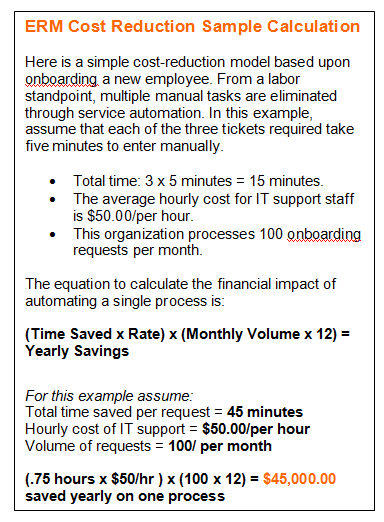Comprehensive Guide to Enterprise IT Service Automation
IT support automation uses software workflows, rule engines, AI/ML, and integrations to automate...
Enterprise request management (ERM) is an approach to service delivery that combines an intuitive Web portal with a back-end automation engine to accelerate fulfillment, enabling workers to request...

Enterprise request management (ERM) is an approach to service delivery that combines an intuitive Web portal with a back-end automation engine to accelerate fulfillment, enabling workers to request any type of service, equipment, or resource via a single intelligent interface, anytime, from any device.
The ERM model reduces service delivery costs and delights users while leveraging much of the technology you already have in place. And it empowers IT professionals to be heroes to the business.
 Other key benefits of an ERM implementation include:
Other key benefits of an ERM implementation include:
But how do you go about proving the value—making the financial case for implementing an ERM strategy?
A new document from Kinetic Data, Process Efficiencies with Kinetic Request: An executive view of the benefits and financial impact of enterprise request management, details the financial value of ERM, how to calculate cost savings, and other factors to take into account when evaluating the financial benefits of this approach.
With ERM, employees can request any “thing” they need to do their jobs, regardless of which internal service group (IT, HR, facilities, finance, legal, etc.) provides that item or service. Productivity as well as user experience are improved because employees have only one (easy) system to use for requesting any type of service, instead of needing to know who provides what and navigating multiple different online (and sometimes paper-based) request processes.
Back-end workflow processes (approvals, scheduling, fulfillment) are automated using orchestration engine software. This process automation reduces costs, eliminates manual efforts, accelerates service delivery, and improves process quality. Process owners can define their own “service items,” mapping and testing task workflows before putting them into production.
ERM is especially valuable for managing complex processes that cross functional boundaries, such as new employee onboarding. Though not required, ERM most often begins with an IT service catalog implementation, then is gradually expanded to other shared services groups.
The document also explains how Kinetic Request and Kinetic Task can enable organizations to implement effective ERM strategies that are scalable, flexible and manageable. For example, according to Gartner, 85% of business processes are initiated by a form. Yet research shows that up to 40% of submitted forms contain missing information that must be manually corrected. By pre-populating forms with “known” information (based on login), presenting questions dynamically (that is, follow-on questions can change based on previous responses), and validating all input, Kinetic Request dramatically reduces the need for manual information correction.
To demonstrate the potential financial value of ERM to your management team, download Process Efficiencies with Kinetic Request: An executive view of the benefits and financial impact of enterprise request management. If your team isn’t familiar with ERM, ask them to watch the movie first.
Next steps:

IT support automation uses software workflows, rule engines, AI/ML, and integrations to automate...

Business process reimagined is the strategic renewal of how work gets done by combining modern digital...

You've probably noticed (what we're calling) the "logo-swap test" lately: all the AI ads in market sound...